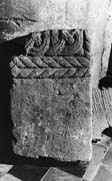Select a site alphabetically from the choices shown in the box below. Alternatively, browse sculptural examples using the Forward/Back buttons.
Chapters for this volume, along with copies of original in-text images, are available here.
Object type: Three fragments, probably from the same shaft or cover
Measurements:
a: L. 61 cm (24 in) W. 38 cm (15 in)
D. 14 cm (5.5 in)
b: L. 25 cm (9.8 in) W. 23 cm (9 in)
D. Built in
c: Unobtainable
Stone type: 3a and b both greyish yellow (10YR 8/3) oolite grainstone, of closely packed 0.4mm diameter ooliths (range 0.3 to 0.5mm). Ancaster Freestone, Upper Lincolnshire Limestone, Inferior Oolite Group
Plate numbers in printed volume: Fig. 9; Ills. 43–5
Corpus volume reference: Vol 5 p. 108-109
(There may be more views or larger images available for this item. Click on the thumbnail image to view.)
Three fragments which probably all originated in the same monument, although the proposed reconstruction given in Butler (1963–4, fig. 1, no. 4) is inaccurate.
Stone 3a. A section from the lower part or the end of a monument. The stone has been split longitudinally and reused as a plinth or string section, at which time three sides were trimmed back removing any original sculpture and a bold chamfer was cut on one of the newly created arrises. Much of the single surviving original face is undecorated although carefully cut. Towards the upper part of the stone, below the broken upper edge, is a panel of interlace in low relief. The panel is divided from the undecorated part of the face below by a double cable moulding, above which the angles of the face are both edged with the remains of single cable moulding. Within the panel are parts of what could be interpreted as two pattern F knots or free rings linked by a paired terminal. However, whilst the left-hand part of the interlace is decorated with a single incised medial line, the right-hand part has a double incised medial line. This discrepancy may mean that the design consisted of two independent runs of interlace.
Stone 3b. A small fragment decorated with interlace in low relief. Only one face is visible. The stone retains a single cable-moulded border within which are parts of what may be two pattern F knots or free rings linked by a pair of diagonal strands. The knots are approximately the same as on 3a, or perhaps larger. The interlace strands are decorated with double medial-incised lines.
Stone 3c. 'Another fragment from the head of this gravestone was noted loose at the west end of the nave in 1953 but is not now (1963) visible' (Butler 1963–4, 109). Its present whereabouts are unknown.
At first sight these fragments appear to be from a characteristic mid-Kesteven grave-cover (Chapter V). The monument is of the appropriate stone type, it has double cabled panels and single cable moulded borders. The interlace is of a similar style and has both single and double incised medial lines. None of the mid-Kesteven group, however, has such a large blank area beyond the interlace as is indicated here. The mid-Kesteven cover at Barrowby has a blank area on its flank beyond the termination of the interlace runs, but the blank area is decorated with an simple incised cross (Ills. 15–16). If this is a section from a mid-Kesteven cover, then, Bicker 3 is unique in having such a large blank area at one end of what is presumably the lid (see reconstruction in Fig. 9). Furthermore, the layout of the interlace on 3a is not easily interpreted as part of the characteristic mid-Kesteven layout. Rather it seems that the face was decorated with two independent runs of interlace, which is more reminiscent of upright shafts such as that at Harmston (Ills. 195–8). 3b is not of great assistance in the analysis as it could be slotted into several different locations in both mid-Kesteven covers and in shafts. Thus, although the scale, style of carving and range of motifs associate the Bicker fragments closely with the mid-Kesteven covers, the monument represented cannot be an orthodox member of the group and they may have come, instead, from an upright shaft. The similarities of style, however, are strong enough to suggest that it may have been produced in the same workshops. Certainly Bicker 3 should be dated by its strong similarities with the mid-Kesteven group to the period between the mid tenth and early eleventh century.



